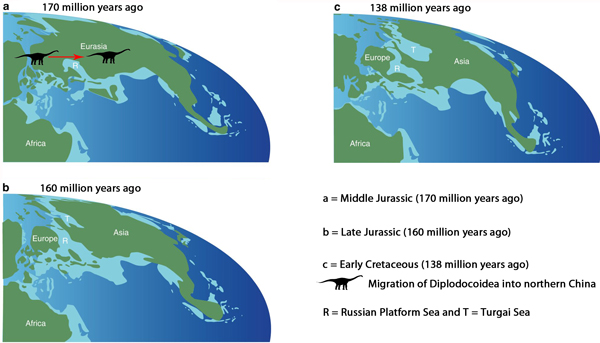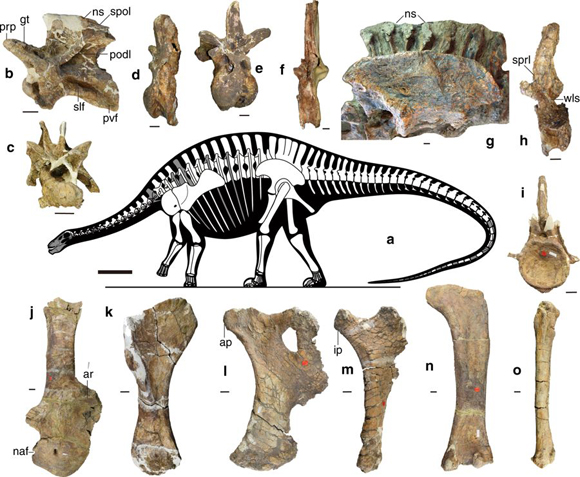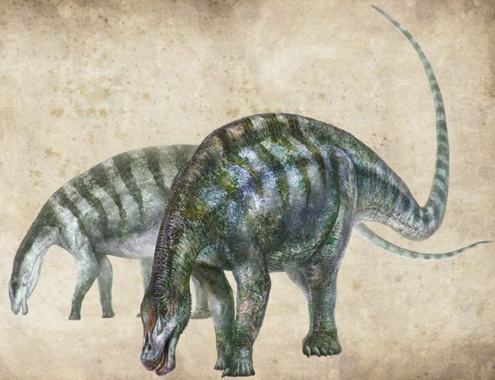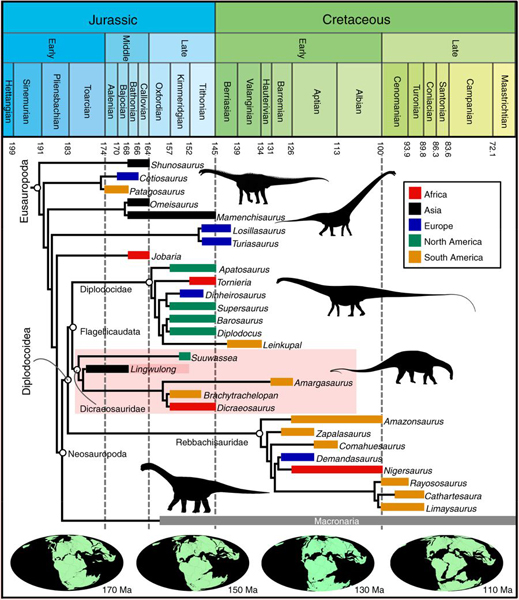Lingwulong shenqi – The Dinosaur That’s Not Supposed to be There
Dinosaurs, so often regarded in the past as epitomising animals that were too slow and stupid to survive, are demonstrating that they were one of the most successful groups of terrestrial vertebrates to have evolved. A newly described, long-necked dinosaur from the Middle Jurassic of northern China suggests that sauropods dispersed and diversified much earlier than palaeontologists had previously thought. The new dinosaur has been named Lingwulong shenqi and it is the earliest known diplodocoid.
A Life Reconstruction of the Newly Described Lingwulong shenqi
Picture credit: Zhang Zongda
Subgroups of Sauropods with Restricted Geographical Ranges
Although the sauropods dominated terrestrial faunas for much of the Mesozoic and their fossils are globally distributed, scientists had been aware that several subgroups demonstrated restricted geographical ranges. For example, the sauropod superfamily Diplodocoidea, which is part of a huge clade of long-necked dinosaurs called the Neosauropoda, was believed to have never existed in eastern Asia. This permitted a unique range of long-necked dinosaurs to evolve and thrive in this part of the world, the Mamenchisauridae. In essence, the isolation of eastern Asia permitted to evolution of the region’s very own endemic range of dinosaurs.
Lingwulong shenqi – The Implications for Dinosaur Distribution
The Neosauropoda consists of two distinct groups of sauropod, firstly there is the Diplodocoidea, this includes some of the most famous dinosaurs of all, animals such as Brontosaurus, Apatosaurus, Diplodocus and Amargasaurus. The second type of sauropod within the Neosauropoda are the Macronaria, which consists of equally famous dinosaurs such as Brachiosaurus and Camarasaurus. It had been thought that once eastern Asia became isolated, the neosauropods were unable to spread to this part of the world.
Their absence had been explained by the break-up of the super-continent Pangaea. A seaway was formed cutting off and isolating this part of Asia during the Jurassic. In the case of the Diplodocoidea, these types of long-necked dinosaur evolved and dispersed but they never reached northern China. By the time sea levels had changed and land connections were once again formed linking northern China to other land masses in the Early Cretaceous, the diplodocoids were in decline and their numbers and geographic range had been greatly reduced since their Late Jurassic heyday.
The discovery of Lingwulong shenqi changes all this. Diplodocoids were present in eastern Asia, so they must have evolved and diversified into this region earlier than previously thought, or land bridges may have existed linking this part of Asia to the rest of Pangaea for longer.
Mapping the Distribution of the Diplodocoidea

Picture credit: Nature Communications with additional annotation by Everything Dinosaur
Co-author of the open access paper published in “Nature Communications”, Dr Philip Mannion (Imperial College London), explained the significance of this dinosaur discovery:
“Not only is it [Lingwulong] the oldest member [of the Diplodocoidea], but it’s the first ever from Asia. For a long time it was thought that neosauropods didn’t get into Asia during the Jurassic. This suggests that firstly [neosauropods] got in before any kind of barrier came up, but increasingly the geological evidence suggests maybe this barrier was quite ephemeral”
The Formation of the Russian Platform Sea and the Turgai Sea
Tectonic forces led to the formation of an epicontinental seaway during the Middle to Late Jurassic and this isolated northern Asia from the rest of Pangaea. The fossils of Lingwulong come from the Yanan Formation in the Ningxia Hui Autonomous Region of China, the strata are estimated to be around 175 to 168 million years old (late Toarcian to Bajocian faunal stages). The discovery of Lingwulong indicates that many advanced kinds of sauropod originated at least 15 million years earlier than previously realised. The Diplodocoidea achieved a global distribution whilst Pangaea was still a single, coherent landmass.
A Reconstruction of the Skeleton of L. shenqi and Examples of Some of the Fossil Bones

Picture credit: Nature Communications
Lingwulong shenqi – “Lingwu’s Amazing Dragon”
The dinosaur has been named after Lingwu, the region in which the fossils were found and the Mandarin Chinese “long” which means dragon. The trivial name – shenqi, comes from the Mandarin for “amazing”, reflecting the unexpected discovery of this type of dinosaur in the Middle Jurassic of China. Excavations originally commenced in 2005 led to the discovery of between 7 and 10 individuals, including two specimens with associated skull material. The fossils represent a range of animal sizes, representing juveniles as well as adults.
With so much fossil material to study, the researchers were able to assign this new genus to a specific place within the broad Superfamily of the Diplodocoidea. They conclude that Lingwulong is a basal member of the Dicraeosauridae.
The Dicraeosauridae includes species such as Suuwassea from the Late Jurassic of Montana, Brachytrachelopan from the Late Jurassic of Argentina and Amargasaurus from the Early Cretaceous of Argentina.
The Position of Lingwulong shenqi Within the Neosauropoda
Picture credit: Nature Communications
The Bigger Picture
The idea that the eastern parts of Asia were cut off from other landmasses during the Jurassic has been put forward to explain the substantial differences between the Jurassic (and sometimes Early Cretaceous), terrestrial biotas between this part of the world and the rest of Pangaea. It is likely that a seaway formed to the west of the Ural Mountains (the Russian Platform Sea), this seaway in conjunction with an ingress of water from the north (the Turgai Sea), isolated the land to the northeast.
This isolation has been used to explain the evolution of a number of new types of prehistoric animal in eastern Asia, such as:
- Mamenchisaurid sauropods
- Oviraptorosaurs
- Therizinosaurs
- Marginocephalians
In addition, this sea barrier has been used to explain the absence of many groups that were present elsewhere in Pangaea during the Jurassic, such as:
- Diplodocoid sauropods (now debunked by Lingwulong)
- Early titanosauriform sauropods
- Dromaeosaurids
- Nodosaurids
- The lineage leading to the iguanodontian ornithopods
The scientific paper: “A New Middle Jurassic Diplodocoid Suggests an Earlier Dispersal and Diversification of Sauropod Dinosaurs” by Xing Xu, Paul Upchurch, Philip D. Mannion, Paul M. Barrett, Omar R. Regalado-Fernandez, Jinyou Mo, Jinfu Ma and Hongan Liu, published in Nature Communications.
Visit the Everything Dinosaur website: Everything Dinosaur.








Leave A Comment